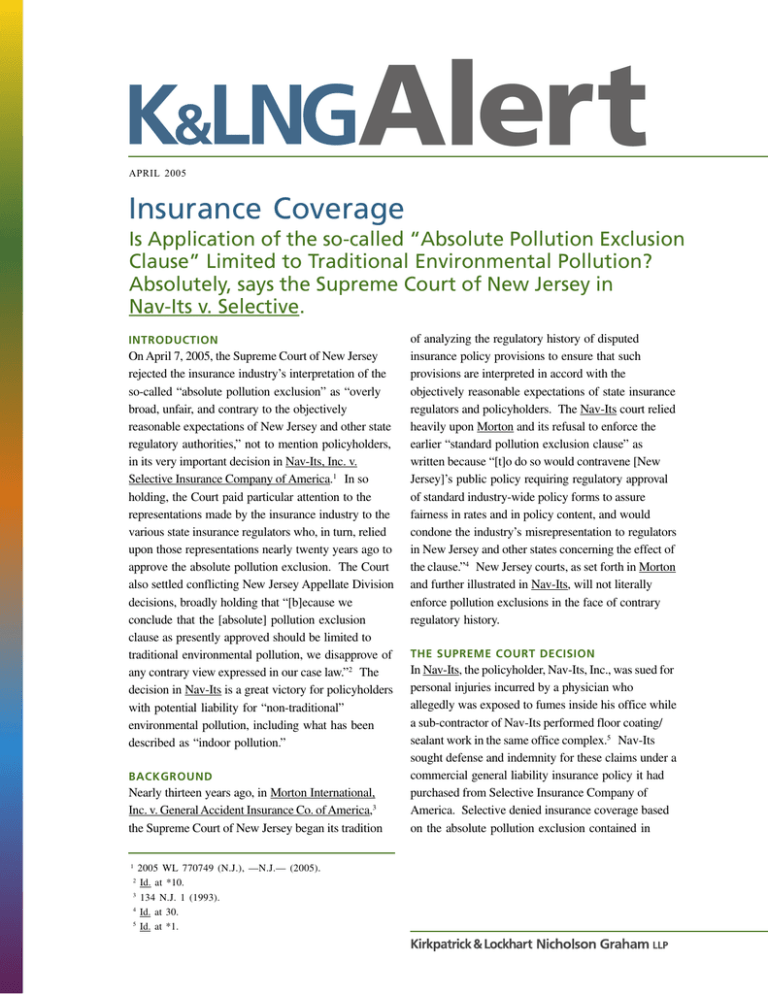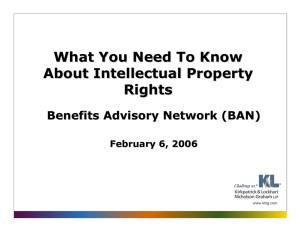
APRIL 2005
Insurance Coverage
Is Application of the so-called “Absolute Pollution Exclusion
Clause” Limited to Traditional Environmental Pollution?
Absolutely, says the Supreme Court of New Jersey in
Nav-Its v. Selective.
INTRODUCTION
On April 7, 2005, the Supreme Court of New Jersey
rejected the insurance industry’s interpretation of the
so-called “absolute pollution exclusion” as “overly
broad, unfair, and contrary to the objectively
reasonable expectations of New Jersey and other state
regulatory authorities,” not to mention policyholders,
in its very important decision in Nav-Its, Inc. v.
Selective Insurance Company of America.1 In so
holding, the Court paid particular attention to the
representations made by the insurance industry to the
various state insurance regulators who, in turn, relied
upon those representations nearly twenty years ago to
approve the absolute pollution exclusion. The Court
also settled conflicting New Jersey Appellate Division
decisions, broadly holding that “[b]ecause we
conclude that the [absolute] pollution exclusion
clause as presently approved should be limited to
traditional environmental pollution, we disapprove of
any contrary view expressed in our case law.”2 The
decision in Nav-Its is a great victory for policyholders
with potential liability for “non-traditional”
environmental pollution, including what has been
described as “indoor pollution.”
BACKGROUND
Nearly thirteen years ago, in Morton International,
Inc. v. General Accident Insurance Co. of America,3
the Supreme Court of New Jersey began its tradition
1
2005 WL 770749 (N.J.), —N.J.— (2005).
Id. at *10.
3
134 N.J. 1 (1993).
4
Id. at 30.
5
Id. at *1.
2
of analyzing the regulatory history of disputed
insurance policy provisions to ensure that such
provisions are interpreted in accord with the
objectively reasonable expectations of state insurance
regulators and policyholders. The Nav-Its court relied
heavily upon Morton and its refusal to enforce the
earlier “standard pollution exclusion clause” as
written because “[t]o do so would contravene [New
Jersey]’s public policy requiring regulatory approval
of standard industry-wide policy forms to assure
fairness in rates and in policy content, and would
condone the industry’s misrepresentation to regulators
in New Jersey and other states concerning the effect of
the clause.”4 New Jersey courts, as set forth in Morton
and further illustrated in Nav-Its, will not literally
enforce pollution exclusions in the face of contrary
regulatory history.
THE SUPREME COURT DECISION
In Nav-Its, the policyholder, Nav-Its, Inc., was sued for
personal injuries incurred by a physician who
allegedly was exposed to fumes inside his office while
a sub-contractor of Nav-Its performed floor coating/
sealant work in the same office complex.5 Nav-Its
sought defense and indemnity for these claims under a
commercial general liability insurance policy it had
purchased from Selective Insurance Company of
America. Selective denied insurance coverage based
on the absolute pollution exclusion contained in
Nav-Its’ insurance policy and Nav-Its sued. Nav-Its
and Selective then filed cross-motions for summary
judgment on the applicability of the absolute
pollution exclusion to the injuries at issue. Nav-Its
prevailed in the trial court and Selective successfully
appealed. The Appellate Division’s holding that the
absolute pollution exclusion clause is “not necessarily
limited to the clean up of traditional environmental
damage” added confusion to New Jersey law on the
issue.6 The Supreme Court of New Jersey granted
certification to settle the issue and, following
Morton’s example, looked to the regulatory history of
the absolute pollution exclusion.
The Court noted that it “had not been presented with
any compelling evidence” that the absolute pollution
exclusion clause, “when approved by the [New Jersey]
Department of Insurance, was intended to be read as
broadly as Selective urge[d].”7 On the contrary, the
record reflected that New Jersey insurance regulators
held hearings in 1985 to determine whether to
approve the absolute pollution exclusion clause:
The regulators were concerned that the thenproposed exclusion sought to sweep too many
potential non-environmental liabilities within its
reach. The insurance industry sought to allay those
fears and, thus, secure the needed approval of the of
this exclusion…[by representing that] the
insurance industry did not intend to use the revised
pollution exclusion as a bar to coverage…[and that
it is not an absolute exclusion.]8
Based on its review of the development of the
absolute pollution exclusion clause, the Nav-Its Court
stated that “we are confident that the history of the
pollution-exclusion clause in its various forms
demonstrates that its purpose was to have a broad
exclusion for traditional environmentally related
damages.”9 The Court also followed a line of state
high court opinions including California,10 Illinois,11
Massachusetts,12 Ohio,13 New York14 and
Washington.15
The Court does not define what “traditional
environmental pollution” includes. As a result,
insurance companies may continue to deny insurance
coverage in borderline cases. Nav-Its provides
policyholders with another weapon to assist in
establishing insurance coverage for non-traditional
pollution claims, and particularly personal injury
claims for exposure to hazardous fumes.
Policyholders should look to the “touchstone” of the
Supreme Court of New Jersey’s decisions in Morton
and Nav-Its:
[t]he insurance industry may not seek approval of a
clause restricting coverage for the asserted reason
of avoiding catastrophic environmental pollution
claims and then use that same clause to exclude
coverage for claims that a reasonable policyholder
would believe were covered by the insurance
policy.16
IMPLICATIONS OF THE NAV-ITS DECISION
First, the decision of the Supreme Court of New Jersey
in Nav-Its unanimously confirms that the insurance
industry’s continued denial of insurance coverage for
“indoor pollution” and other types of non-traditional
environmental pollution claims should be rejected
under New Jersey law. Second, it enforces the
6
Id. at *2. The Supreme Court of New Jersey noted that the prior New Jersey Appellate Division decisions could be “read as in
conflict.” Id. at *10 (citing S.N. Golden Estates, Inc. v. Continental Casualty Co. 293 N.J. Super. 395, 402 (App. Div. 1996) (the
“absolute pollution exclusion was intended to apply only to environmental claims, and not to claims of personal injury or property
damage which can be separated from the substance’s environmental toxicity”); Byrd ex rel. Byrd v. Blumenreich, 317 N.J. Super.
496, 504 (App. Div. 1999) (the absolute pollution exclusion is “ambiguous in the absence of specific language excluding from
coverage injury or damage caused by the indoor residential exposure to lead paint”); and Leo Haus, Inc. v. Selective Insurance Co.,
353 N.J. Super. 67 (App. Div. 2002) (the absolute pollution exclusion is not limited to traditional environmental pollution)).
7
Id. at *8.
8
Id. at *7.
9
Id.
10
MacKinnon v. Truck Insurance Exchange, 73 P.3d 1205 (Cal. 2003).
11
Am. States Insurance Co. v. Koloms, 687 N.E.2d 72 (Ill. 1997).
12
MacKinnon v. Truck Insurance Exchange, 73 P.3d 1205 (Cal. 2003).
13
Am. States Insurance Co. v. Koloms, 687 N.E.2d 72 (Ill. 1997).
14
Belt Painting Corp. v. TIG Insurance Co., 795 N.E.2d 15 (N.Y. 2003).
15
Kent Farms v. Zurich Insurance Co., 998 P.2d 292 (Wash. 2000).
16
Id. at *8.
2 APRIL 2005
KIRKPATRICK & LOCKHART NICHOLSON GRAHAM LLP
safeguard that revisions to the pollution exclusion to
further restrict coverage of risks “must be fully and
unambiguously disclosed to regulators and the
public.”17 Finally, policyholders should carefully
scrutinize, in light of the Nav-Its decision, prior and
future denials of insurance coverage based on the
absolute pollution exclusion clause and fight for any
claims they reasonably expected would be covered
when they purchased the insurance coverage to begin
with.
17
Donald W. Kiel
dkiel@klng.com
973.848.4064
Robert F. Pawlowski
rpawlowski@klng.com
973.848.4032
Id. at *10.
If you have questions or would like more information about K&LNG’s Insurance Coverage Practice,
please contact one of our lawyers listed below:
International Contact
Boston
Dallas
Harrisburg
London
Los Angeles
Miami
Newark
New York
Pittsburgh
San Francisco
Washington
Peter J. Kalis
John M. Edwards
Robert Everett Wolin
Carleton O. Strouss
John Magnin
David P. Schack
Daniel A. Casey
Anthony P. La Rocco
Eugene R. Licker
James R. Segerdahl
Edward P. Sangster
Matthew L. Jacobs
pkalis@klng.com
jedwards@klng.com
rwolin@klng.com
cstrouss@klng.com
jmagnin@klng.com
dschack@klng.com
dcasey@klng.com
alarocco@klng.com
elicker@klng.com
jsegerdahl@klng.com
esangster@klng.com
mjacobs@klng.com
+1.412.355.6562
+1.617.261.3123
+1.214.939.4909
+1.717.231.4503
+44 (0) 20 7648 8168
+1.310.552.5061
+1.305.539.3324
+1.973.848.4014
+1.212.536.3916
+1.412.355.6784
+1.415.249.1028
+1.202.778.9393
Fax
Fax
Fax
Fax
Fax
Fax
Fax
Fax
Fax
Fax
Fax
Fax
+1.412.355.6501
+1.617.261.3175
+1.214.939.4949
+1.717.231.4501
+44 (0) 20 7648 9001
+1.310.552.5001
+1.305.358.7095
+1.973.848.4001
+1.212.536.3901
+1.412.355.6501
+1.415.249.1001
+1.202.778.9100
www
w.. k l n g . c o m
BOSTON
DALLAS
HARRISBURG
LONDON
LOS ANGELES
MIAMI
NEWARK
NEW YORK
PITTSBURGH
SAN FRANCISCO
WASHINGTON
Kirkpatrick & Lockhart Nicholson Graham LLP (K&LNG) has approximately 950 lawyers and represents entrepreneurs, growth and middle market
companies and leading FORTUNE 100 and FTSE 100 global corporations nationally and internationally.
K&LNG is a combination of two limited liability partnerships, each named Kirkpatrick & Lockhart Nicholson Graham LLP, one qualified in Delaware, U.S.A.
and practicing from offices in Boston, Dallas, Harrisburg, Los Angeles, Miami, Newark, New York, Pittsburgh, San Francisco and Washington and one
incorporated in England practicing from the London office.
This publication/newsletter is for informational purposes and does not contain or convey legal advice. The information herein should not be used or relied
upon in regard to any particular facts or circumstances without first consulting a lawyer.
Unless otherwise indicated, the lawyers are not certified by the Texas Board of Legal Specialization.
Data Protection Act 1988 - We may contact you from time to time with information on Kirkpatrick & Lockhart Nicholson Graham LLP seminars and with our
regular newsletters, which may be of interest to you. We will not provide your details to any third parties. Please e-mail cgregory@klng.com if you would
prefer not to receive this information.
© 2005 KIRKPATRICK & LOCKHART NICHOLSON GRAHAM LLP. ALL RIGHTS RESERVED.






